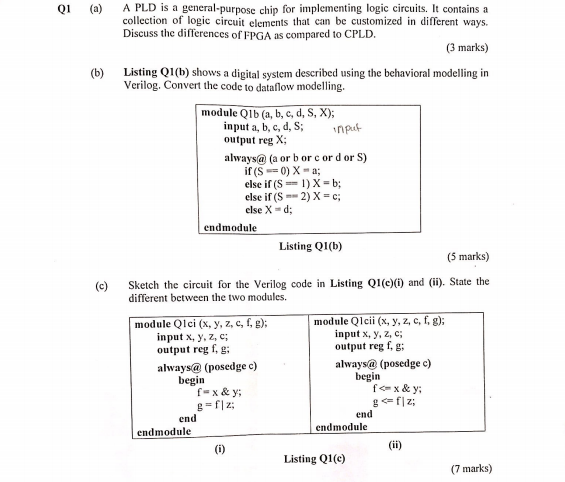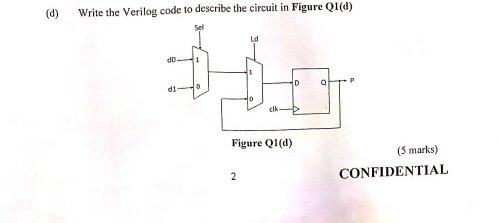Answered step by step
Verified Expert Solution
Question
1 Approved Answer
please step by step and clear QI (a) A PLD is a general-purpose chip for implementing logic circuits. It contains a collection of logic circuit


please step by step and clear
QI (a) A PLD is a general-purpose chip for implementing logic circuits. It contains a collection of logic circuit elements that can be customized in different ways. Discuss the differences of FPGA as compared to CPLD. (3 marks) (6) Listing Q1(b) shows a digital system described using the behavioral modelling in Verilog. Convert the code to dataflow modelling. module Q1b (a, b, c, d, S, X); input a, b, c, d, S: input output reg X; always@ (a or b or cord or S) if(s ==0) X - a; else if(s == 1)X = b; else if ( S2) X=c; else X -d; endmodule Listing Q1(b) (5 marks) (c) Sketch the circuit for the Verilog code in Listing Q1(c)) and (ii). State the different between the two modules. module Qlci (x, y, z, c, , g): module Qlcii (x, y, 2, C, fig); input x, y, z, input x, y, z, ; output regfg output reg f.g always@ (posedge c) always@ (posedge c) begin begin fax&y; fox & y g=f|z; gwf|z; end end endmodule endmodule (0) Listing Q10 (7 marks) (d) Write the Verilog code to describe the circuit in Figure Q1(d) Sel ud db D di 0 o Figure Q1(d) (5 marks) CONFIDENTIAL 2 QI (a) A PLD is a general-purpose chip for implementing logic circuits. It contains a collection of logic circuit elements that can be customized in different ways. Discuss the differences of FPGA as compared to CPLD. (3 marks) (6) Listing Q1(b) shows a digital system described using the behavioral modelling in Verilog. Convert the code to dataflow modelling. module Q1b (a, b, c, d, S, X); input a, b, c, d, S: input output reg X; always@ (a or b or cord or S) if(s ==0) X - a; else if(s == 1)X = b; else if ( S2) X=c; else X -d; endmodule Listing Q1(b) (5 marks) (c) Sketch the circuit for the Verilog code in Listing Q1(c)) and (ii). State the different between the two modules. module Qlci (x, y, z, c, , g): module Qlcii (x, y, 2, C, fig); input x, y, z, input x, y, z, ; output regfg output reg f.g always@ (posedge c) always@ (posedge c) begin begin fax&y; fox & y g=f|z; gwf|z; end end endmodule endmodule (0) Listing Q10 (7 marks) (d) Write the Verilog code to describe the circuit in Figure Q1(d) Sel ud db D di 0 o Figure Q1(d) (5 marks) CONFIDENTIAL 2Step by Step Solution
There are 3 Steps involved in it
Step: 1

Get Instant Access to Expert-Tailored Solutions
See step-by-step solutions with expert insights and AI powered tools for academic success
Step: 2

Step: 3

Ace Your Homework with AI
Get the answers you need in no time with our AI-driven, step-by-step assistance
Get Started


